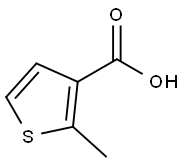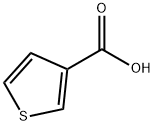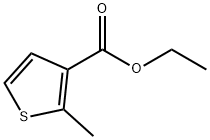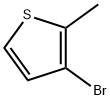
2-METHYL-THIOPHENE-3-CARBOXYLIC ACID synthesis
- Product Name:2-METHYL-THIOPHENE-3-CARBOXYLIC ACID
- CAS Number:1918-78-1
- Molecular formula:C6H6O2S
- Molecular Weight:142.18

88-13-1

74-88-4

1918-78-1
The general procedure for the synthesis of 2-methyl-3-thiophenecarboxylic acid (compound 9) from 3-thiophenecarboxylic acid (compound 8) and iodomethane was carried out as follows: the synthesis was carried out according to the method described in literature [24]. Slowly n-butyllithium (n-BuLi, 1.6 M hexane solution, 1.50 L, 2.40 mol) was added dropwise to a tetrahydrofuran (THF, 2.3 L) solution of diisopropylamine (233 g, 2.30 mol) at 0 °C. After keeping stirring at 0 °C for 40 min, the reaction mixture was cooled to -60 °C and a THF (500 mL) solution of compound 8 (223 g, 1.74 mol) was slowly added and stirring was continued for 1 h at -60 °C. Subsequently, iodomethane (MeI, 254 g, 1.79 mol) was added and the reaction mixture was gradually warmed to room temperature and stirred for 1 hour. After completion of the reaction, the mixture was concentrated under reduced pressure, acidified to pH 1 with aqueous 6N hydrochloric acid and extracted with ethyl acetate (AcOEt). The organic layer was washed with brine and dried over anhydrous sodium sulfate (Na2SO4). After filtration, the solvent was removed by concentration under reduced pressure and the residue was crystallized from water/acetic acid (H2O/AcOH) to give 209 g (85% yield) of compound 9 as a light yellow solid. Its nuclear magnetic resonance hydrogen spectrum (1H NMR, 400 MHz, CDCl3) data were as follows: δ 7.45 (d, J = 5.4 Hz, 1H), 7.01 (d, J = 5.4 Hz, 1H), 2.78 (s, 3H); mass spectrum (MS, ESI) m/z: 143 ([M + H]+), 141 ([M - H]-).

74-88-4
357 suppliers
$15.00/10g

1918-78-1
84 suppliers
$9.00/250mg
Yield: 20%
Reaction Conditions:
Stage #1:3-Thiophene carboxylic acid with n-butyllithium;diisopropylamine in tetrahydrofuran;hexane at -78 - 0; for 1.16667 h;
Stage #2:methyl iodide in tetrahydrofuran;hexane at -78 - 20; for 1 h;
Stage #3: with hydrogenchloride;water in tetrahydrofuran;hexane
Steps:
27.a
EXAMPLE 27; Preparation of 2-Amino-5-(2-methylthien-3-yl)-3-methyl-5-(3-pyrimidin-5-ylphenyl)-3,5-dihydro-4H-imidazol-4-one; Step a); Preparation of Compound 19; A solution of diisopropylamine (8.28 g, 81.8 mmol) in THF (190 mL) at -20° C. was treated with n-butyllithium (52 mL of a 1.6 M solution in hexanes, 83.2 mmol) over a period of 20 min, then slowly warmed to 0° C. under stirring for 30 min. This solution was cooled to -78° C. and treated dropwise with a solution of thiophene-3-carboxylic acid (4.99 g, 38.9 mmol) in THF (40 mL) over a period of 10 min. The mixture was stirred at -78° C. for an additional 10 min, then treated with iodomethane (6.16 g, 43.3 mmol) and stirred for 1 h, allowing the solution to slowly warm to rt. Water (200 mL) was added, and the mixture was made acidic by adding 2 N HCl (40 mL). The layers were separated and the aqueous layer was extracted with ether (3×75 mL), then the combined organic layers were dried over sodium sulfate, filtered and concentrated. Purification by flash chromatography (silica, 50:50:1 ethyl acetate/hexanes/acetic acid) afforded 19 (1.12 g, 20%) as a white solid: 1H NMR (500 MHz, CDCl3) δ 7.45 (d, J=5.4 Hz, 1H), 7.01 (t, J=5.4 Hz, 1H), 2.77 (s, 3H).
References:
Location in patent:Page/Page column 18-19

60-29-7
0 suppliers
$30.00/50g

88-13-1
375 suppliers
$5.00/1g

74-88-4
357 suppliers
$15.00/10g

1918-78-1
84 suppliers
$9.00/250mg

19432-66-7
64 suppliers
$45.00/1g

1918-78-1
84 suppliers
$9.00/250mg

30319-05-2
89 suppliers
$28.00/1g

124-38-9
134 suppliers
$175.00/23402

1918-78-1
84 suppliers
$9.00/250mg